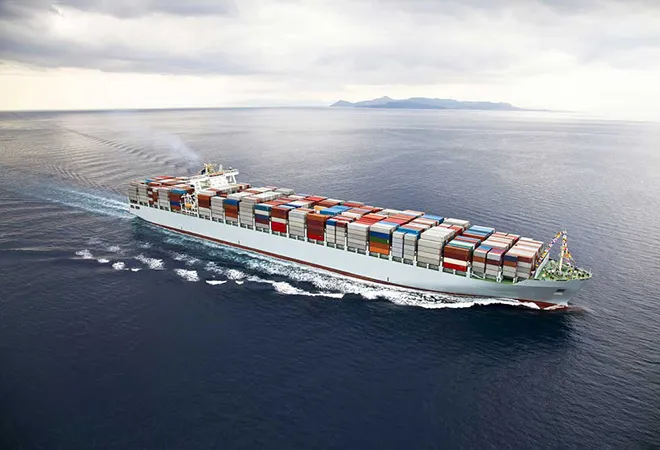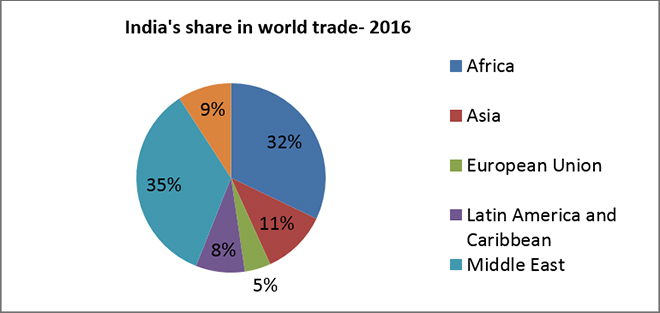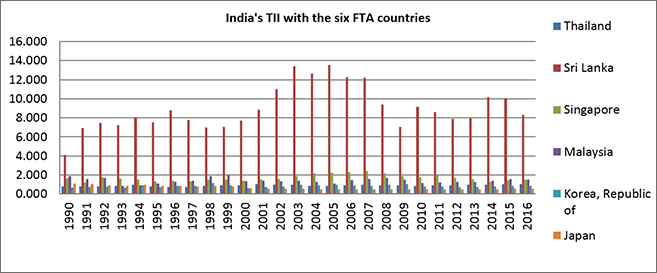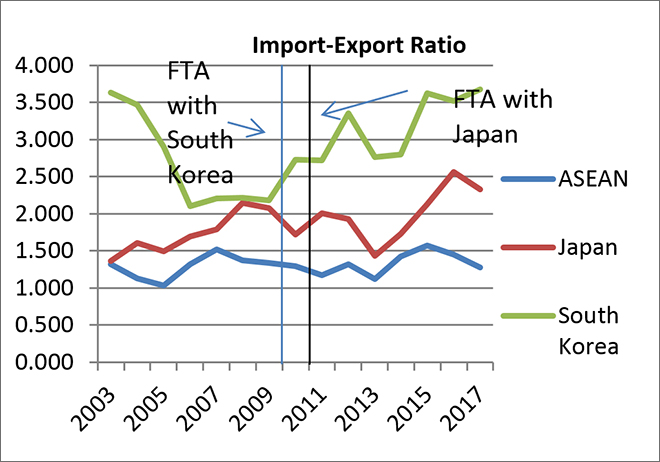
India has been a newcomer in the arena of Regional Trade Agreements (RTAs). It began the process of integration with the rest of the world only after the 1991 reforms. According to the Asian Development Bank database on RTAs, India has signed, and put in effect, 13 RTAs as of now. RTAs refer to integration of the signatory states through tariff reductions or abolition between them, establishment of a standard discriminatory tariff for non-member states, flexible movement of factors of production within the region, setting up a common market and finally, economic and monetary union. Each of these represents successive higher levels of integration among the signatory nations.
India has successfully negotiated RTAs predominantly of the first two types, namely Free Trade Agreements and Preferential Trade Agreements. Albeit, negotiations for a comprehensive agreement for economic cooperation are underway with several nations/regions such as the Regional Comprehensive Economic Partnership (RCEP) between India and the ASEAN and six other countries from the Asia- Pacific region, with which ASEAN has existing FTAs. The following table shows the list of trade agreements signed by India:
| < style="color: #ffffff">AGREEMENT |
< style="color: #ffffff">STATUS |
< style="color: #ffffff">YEAR |
| ASEAN-India Comprehensive Economic Cooperation Agreement |
Signed and In Effect |
2010 |
| Asia-Pacific Trade Agreement |
Signed and In Effect |
1976 |
| India-Afghanistan Preferential Trading Agreement |
Signed and In Effect |
2003 |
| India-Bhutan Trade Agreement |
Signed and In Effect |
2006 |
| India-Chile Preferential Trading Agreement |
Signed and In Effect |
2007 |
| India-MERCOSUR Preferential Trade Agreement |
Signed and In Effect |
2009 |
| India-Singapore Comprehensive Economic Cooperation Agreement |
Signed and In Effect |
2005 |
| India-Sri Lanka Free Trade Agreement |
Signed and In Effect |
2001 |
| India- Korea Comprehensive Economic Partnership Agreement |
Signed and In Effect |
2010 |
| Indo-Nepal Treaty of Trade |
Signed and In Effect |
2002 |
| Japan-India Comprehensive Economic Partnership Agreement |
Signed and In Effect |
2011 |
| Malaysia-India Comprehensive Economic Cooperation Agreement |
Signed and In Effect |
2011 |
| South Asian Free Trade Area |
Signed and In Effect |
2006 |
Table 1.1
Source: Asian Development Bank, Asia Regional Integration Centre.
Despite being a late entrant, India is showing the enthusiasm of a newcomer in signing trade agreements with nations from all corners of the globe. Trade agreements with the European Union, Russia, MERCOSUR (Brazil, Argentina, Uruguay, Venezuela and Paraguay), Gulf Cooperation Council (Bahrain, Kuwait, Oman, Qatar, Saudi Arabia and the UAE), Iceland, Liechtenstein, Norway and Switzerland (under the India-European Free Trade Area Economic Partnership Agreement), Egypt, China and Chile are in the pipeline. Such intensive proliferation of trade agreements were based on the objective of the Commerce Ministry to "double India's exports of goods and services by 2014 with a long-term objective of doubling India's share in global trade by the end of 2020 through appropriate policy support" (Department of Commerce, 2011).
The economic logic behind such lofty ambitions was promoted by Jacob Viner (1951) in his pioneering work on Customs Union. According to the Vinerian theory, ‘trade creating’ effects of RTAs would enhance the welfare of the entire region. Trade creation refers to the phenomenon of an increase in intra region trade following the reduction in barriers to trade. However such RTAs could also lead to deterioration in welfare for the region. If, as a result of the trade agreements, goods are being imported from within the trade bloc of an inferior quality as compared to the one prior to the agreement, there would be a significant loss in consumer surplus as the quality of the product deteriorates. This is referred to as the ‘trade diverting’ effect of RTAs. Noted economist Jagdish Bhagwati has shown that despite the adverse trade diversion effects, an RTA can still be welfare improving via efficiency gains -- an increase in productivity arising out of specialisation in the good in which a country enjoys comparative advantage, and improvement in consumer welfare through access to cheaper products (Bhagwati, 1971). These arguments have supported the formation of RTAs and a World Bank (2005) study estimates that on an average, each WTO member is part of six RTAs. India has been no exception to this.
The relative importance of India in global trade can be perceived from the figure below. An Asian Development Bank Asia Regional Integration Centre estimate reveals that majority of Indian trade, in 2016, was with the Middle East (35%) and Africa (32%).
Figure1.1
 Source: Asian Development Bank, Asia Regional Integration Centre.
Source: Asian Development Bank, Asia Regional Integration Centre.
However, most trade agreements have been signed with Asian countries. This was done, perhaps, with the motive of increasing the economic and political importance of Asia and becoming the most important competitor of the European Union. India has already signed FTAs with Japan, South Korea, Malaysia, Singapore, Thailand and Sri Lanka. The number of proposed trade agreements is also increasing in an unprecedented manner. But before the Government goes ahead with signing a few more trade agreements, one must analyse and understand whether these agreements have achieved the objective of ‘trade creation’ and welfare improvement. In light of this, we look into a few statistics that help capture the level of integration achieved between the nations through these RTAs. The Trade Intensity Index (TII) estimates whether the value of trade between two countries is greater or smaller than would be expected on the basis of their importance in world trade. The following table represents the TII of India with the six countries. A TII value greater than 1 indicates that trade relations between the two nations is intense.
Figure 1.2
 Source: Asian Development Bank, Asia Regional Integration Centre.
Source: Asian Development Bank, Asia Regional Integration Centre.
With the exception of Sri Lanka, none of the countries have had a TII value significantly greater than 1. Moreover, the trend seems to remain the same over the period 1990-2016. Therefore, the signing of RTAs has not led to further integration between India and these countries. This is in strict contrast to the arguments in favour of RTAs. Thus, it is justified to conclude that these RTAs haven’t been able to achieve trade creation to the extent envisaged.
This can be attributed to India’s overzealous emphasis on ‘market access’ while signing these trade agreements. It was expected that wider market access would increase India’s share in global trade. However, such a policy is highly dependent on supply side factors and elimination of Non-Tariff Barriers (NTBs). But as opposed to the WTO norms, NTBs are omnipresent among the six countries. The South East Asian region is fraught with geopolitical tensions, despite linguistic and ethnic similarities. In addition to geopolitical tensions, several NTBs have been indentified that hinder the complete and proper integration of India with these six nations. Lack of cooperation in mutual recognition of certificates, varying packaging and labeling requirements, para- tariffs, inadequate facilities and high charges for quarantine and warehousing measures, complicated trade financing, information asymmetries and poor harmonisation and modernisation of procedures are some of the NTBs that have been identified as barriers to trade in this part of the world (Prasai, 2015).
Another interesting finding from the data related to RTAs reveal that India’s exports to the member countries has been inadequate, except for a few countries like Sri Lanka. Table 1.3 suggests that RTAs have benefitted the partners more. This reflects India’s inability to expand its export potential with the partner countries. Therefore, even if the argument of gains from free trade is to be exploited, the outcome would be highly skewed in favour of the partner countries. While the theory would suggest a mechanism of compensation to the ‘losers’ by the ‘winners’, such compensation is not feasible in the real world. The entire argument in favour of freer trade and subsequent Pareto improvement, thus, fails.
Figure 1.3
 Source: COMTRADE
Source: COMTRADE
In view of the above facts, it would be prudent if the government took a cautious stance towards signing new trade agreements. The government must conduct an in-depth analysis of the consequences of an RTA by forming a multi-stakeholder committee. In this manner, the interests of both consumers and producers would be protected.
Improving the export potential of the nation by reducing transaction costs is another major area where we have under achieved our potential. The improvement in India’s Ease of Doing Business ranking released by the World Bank -- from 130 in 2017 to 100 in 2018 -- is a step in the right direction. India’s attractiveness as an investment destination will determine the inflow of foreign investment. Foreign investment in infrastructure, research and development will lead to spillover effects that will help enhance the overall productivity of the economy, leading to more competitive exports.
Instead of indiscriminately signing RTAs, the government must enhance its ability to harness domestic resources to its best potential. For this purpose, external help might be required and hence emphasis should be put on improving the Ease of Doing Business parameters and Competitiveness indicators. India’s attractiveness as an FDI destination must be improved, especially with the emergence of China as the world’s largest FDI destination. In other words, RTAs alone will not help improve India’s position in world trade.
The author is a Research Assistant at Observer Research Foundation, Kolkata
The views expressed above belong to the author(s). ORF research and analyses now available on Telegram! Click here to access our curated content — blogs, longforms and interviews.




 Source: Asian Development Bank, Asia Regional Integration Centre.
Source: Asian Development Bank, Asia Regional Integration Centre. Source: Asian Development Bank, Asia Regional Integration Centre.
Source: Asian Development Bank, Asia Regional Integration Centre. Source: COMTRADE
Source: COMTRADE PREV
PREV

